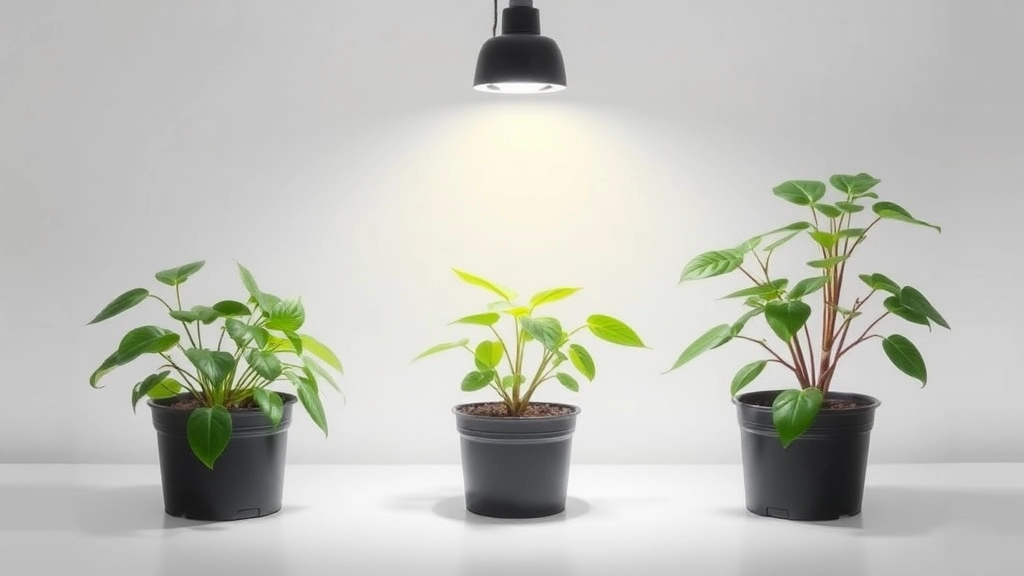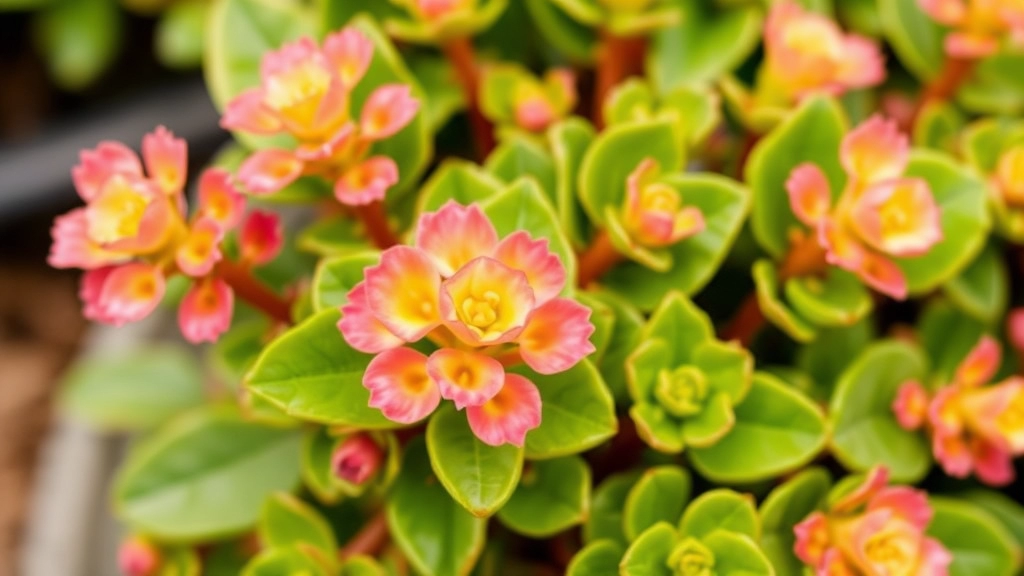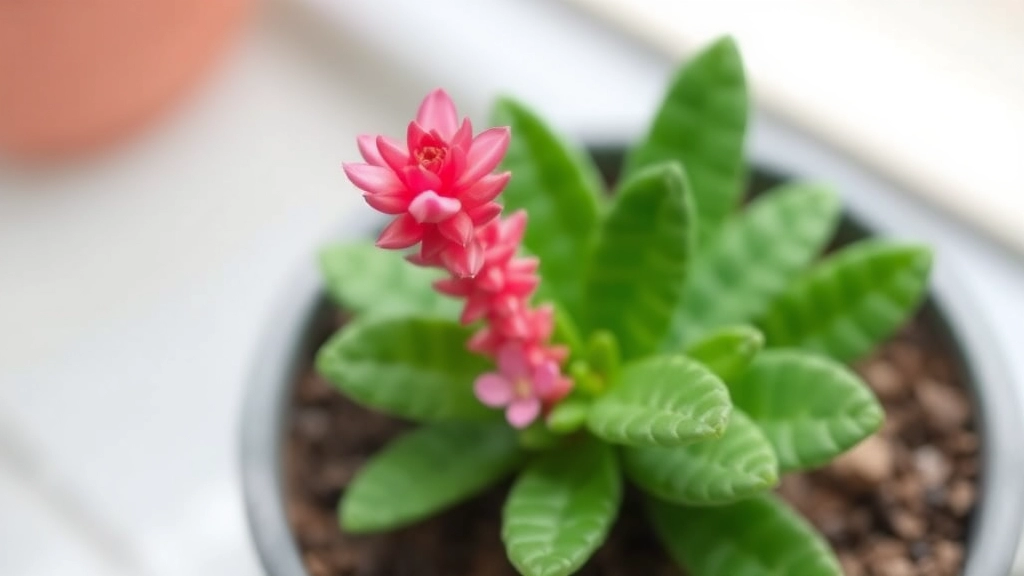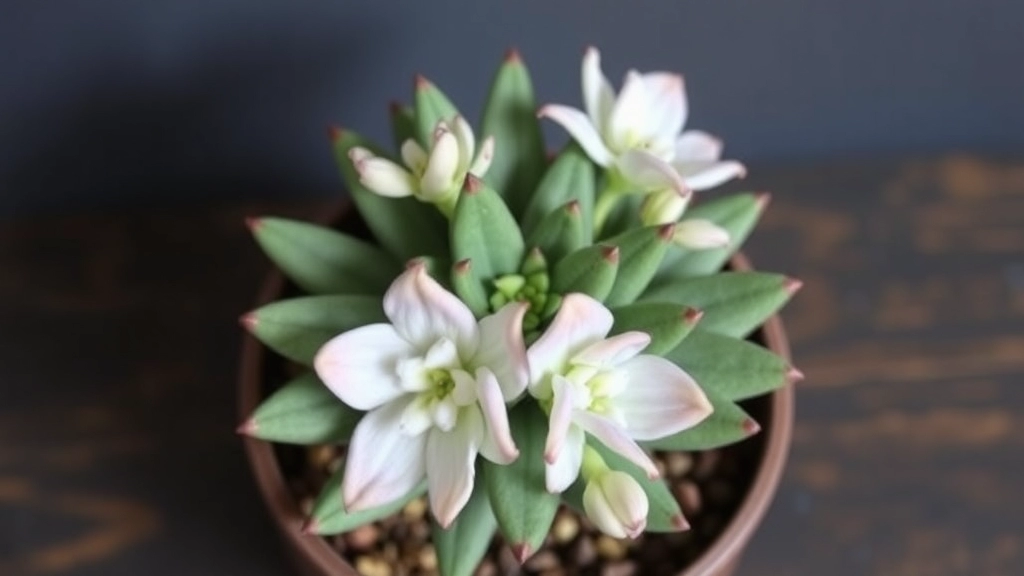Kalanchoe Pinnata Air Plant Care Guide
Are you curious about the Kalanchoe Pinnata Air Plant and how to care for it? This fascinating plant, also known as the air plant, is loved for its easy maintenance and unique ability to propagate through plantlets on its leaves. Whether you’re a seasoned gardener or a beginner, understanding the best growing conditions, light requirements, and watering techniques can make all the difference in keeping your Kalanchoe Pinnata thriving.
In addition to its horticultural appeal, the Kalanchoe Pinnata offers medicinal benefits, making it a valuable addition to any home. From propagation methods using leaf and stem cuttings to managing common pests and diseases, this guide covers everything you need to know. Dive in to discover the secrets of optimal soil mix, potting tips, and the ideal temperature and humidity levels for your air plant. Let’s get started on your journey to mastering Kalanchoe Pinnata care!
Best Growing Conditions for Kalanchoe Pinnata
When it comes to growing Kalanchoe Pinnata, many enthusiasts often wonder about the ideal conditions to ensure vibrant health and growth.
Optimal Environment
Kalanchoe Pinnata thrives in environments that mimic its native tropical habitat. Here are some key factors to consider:
- Light: Bright, indirect sunlight is crucial. Too much direct sunlight can scorch the leaves, while too little can hinder growth.
- Temperature: This plant prefers warm temperatures, ideally between 20°C to 30°C. Protect it from frost and cold drafts. For more details, check out the ideal temperature for Kalanchoe Blossfeldiana growth.
- Humidity: Moderate humidity levels are best. While Kalanchoe can tolerate lower humidity, excessively dry conditions may lead to stress.
Potting and Location
Choosing the right pot and location is equally important:
- Container: Use pots with drainage holes to prevent waterlogging. Terracotta pots are a great option as they allow the soil to breathe. Learn more about the best soil for Kalanchoe Blossfeldiana care.
- Placement: Position your Kalanchoe Pinnata near a window where it can receive ample light without the harshness of direct sun.
Light Requirements for Optimal Growth

So, you’ve got your Kalanchoe Pinnata, and you’re wondering how to give it the best light possible? You’re not alone! Many plant lovers face the same dilemma.
Understanding Light Needs
Kalanchoe Pinnata thrives in bright, indirect sunlight.
- Direct Sunlight: Too much can scorch those lovely leaves.
- Low Light: This plant can survive in lower light but won’t flourish.
Ideal Light Conditions
Here’s how to set your Kalanchoe up for success:
- Location: A south or west-facing window is perfect.
- Duration: Aim for about 6 hours of light daily.
Signs Your Plant Is Happy
Keep an eye on these signs to ensure your Kalanchoe is getting the right amount of light:
- Vibrant Leaves: Bright green and plump leaves mean all is well.
- Leggy Growth: If it starts stretching towards the light, it’s craving more.
Adjusting Light Exposure
If you notice signs of distress, consider these tips:
- Rotate Your Plant: This encourages even growth.
- Move It: If it’s too leggy or burnt, try a different spot.
When it comes to caring for Kalanchoe Pinnata, one of the most common concerns is how often to water. Overwatering can lead to root rot, while underwatering can cause the plant to wilt.
### Understanding the Watering Needs
Kalanchoe Pinnata is a succulent, which means it stores water in its leaves. This unique characteristic influences its watering schedule significantly.
– **Frequency**: Water every 2-3 weeks during the growing season (spring and summer).
– **Winter Care**: Reduce watering to once a month in the dormant winter months.
– **Soil Check**: Always check the top inch of the soil; if it feels dry, it’s time to water.
### Techniques for Effective Watering
The method you use to water Kalanchoe Pinnata can make a big difference in its health.
– **Bottom Watering**: Place the pot in a tray of water and allow it to absorb moisture from the bottom. This helps prevent water from sitting on the leaves, which can cause rot.
– **Soaking Method**: Water thoroughly until it drains from the bottom. Ensure the pot has drainage holes to avoid standing water.
– **Misting**: Avoid misting the leaves, as Kalanchoe Pinnata prefers dry conditions.
### Signs of Over or Underwatering
Keeping an eye on your plant will help you adjust your watering routine effectively.
– **Overwatering**: Yellowing leaves, mushy stems, or a foul smell from the soil.
– **Underwatering**: Wrinkled leaves, browning edges, or drooping stems.
For more detailed care tips, you might find our guide on [how to grow and care for Kalanchoe Pinnata](https://planthq.org/how-to-grow-and-care-for-kalanchoe-pinnata-tips-and-benefits/) useful. Additionally, understanding the [health benefits of Kalanchoe Pinnata](https://planthq.org/health-benefits-of-kalanchoe-pinnata-a-complete-guide/) can offer more insights into this versatile plant.
IV. Soil Mix and Potting Tips for Kalanchoe Pinnata
When it comes to creating the perfect environment for your Kalanchoe Pinnata, the soil mix and potting method play a crucial role.
Choosing the Right Soil Mix
Kalanchoe Pinnata thrives in well-draining soil. Here are some key points to consider:
- Cactus or Succulent Mix: A pre-made cactus mix is ideal as it allows for proper drainage and aeration.
- DIY Soil Mix: If you prefer a homemade option, combine:
- 50% potting soil
- 25% coarse sand
- 25% perlite or pumice
This blend mimics the plant’s natural habitat, ensuring it doesn’t sit in excess moisture.
Potting Tips
Selecting the right pot is just as important as the soil. Here’s how to pot your Kalanchoe Pinnata effectively:
- Choose a Pot with Drainage Holes: Ensuring water can escape prevents root rot.
- Size Matters: Opt for a pot that is slightly larger than the root ball. This allows room for growth without holding too much excess moisture.
- Layering Technique: Consider adding a layer of gravel at the bottom of the pot to enhance drainage.
Repotting Considerations
If you notice your Kalanchoe Pinnata outgrowing its pot, repotting is essential. Here’s a simple guide:
- Timing: Spring is the best time to repot, as the plant is actively growing.
- Gently Remove: Carefully take the plant out, shaking off excess soil without damaging the roots.
- Refresh the Soil: Replace the old soil with fresh mix to provide nutrients.
By following these soil mix and potting tips, your Kalanchoe Pinnata will flourish in its new home.
Propagation Methods: Leaf and Stem Cuttings
When it comes to expanding your collection of Kalanchoe Pinnata, understanding effective propagation methods is essential. Many enthusiasts often wonder how to successfully propagate this resilient plant.
Leaf Cuttings
Leaf cuttings are one of the simplest ways to propagate Kalanchoe Pinnata. Here’s how to do it:
- Select a Healthy Leaf: Choose a mature, healthy leaf from the parent plant.
- Cut and Dry: Use a clean, sharp knife to cut the leaf. Allow it to dry for a few hours to form a callus on the cut edge. This helps prevent rot.
- Planting: Place the callused leaf on well-draining soil. You can lightly press it into the soil but avoid burying it completely.
- Watering: Mist the soil lightly to keep it slightly moist.
- Light Conditions: Place the cutting in bright, indirect light.
Stem Cuttings
Stem cuttings are another effective method for propagation. Here’s how to do it:
- Choose a Healthy Stem: Select a stem that is firm and healthy.
- Make the Cut: Cut a segment of the stem about 4-6 inches long, ensuring it has at least a few leaves.
- Drying: Allow the cut end to dry for a few hours to reduce the risk of rot.
- Planting: Insert the cut end into well-draining soil, burying it about an inch deep.
- Watering: Water lightly and keep the soil moist but not soggy.
- Light Conditions: Position the cutting in bright, indirect light.
Tips for Successful Propagation
- Patience is Key: It may take a few weeks for roots to develop, so be patient.
- Monitor Moisture: Overwatering is a common mistake. Ensure the soil is well-draining.
- Temperature: Keep the cuttings in a warm environment to encourage growth.
By following these straightforward steps, you can easily propagate Kalanchoe Pinnata through leaf and stem cuttings. This not only enriches your plant collection but also allows for sharing with friends and family. For more detailed guidance, check out our tips and benefits for growing Kalanchoe Pinnata. Additionally, if you are interested in the health benefits of this plant, read our comprehensive guide on the health benefits of Kalanchoe Pinnata.
Managing Common Pests and Diseases in Kalanchoe Pinnata

So, you’ve got your Kalanchoe Pinnata thriving, but what happens when those pesky pests or diseases show up?
Let’s dive into how to keep your plant healthy and happy.
Common Pests
- Aphids: Tiny green bugs that suck the sap from your plant.
- Signs: Curling leaves and sticky residue.
- Solution: Spray with a mix of water and mild soap or introduce ladybugs.
- Mealybugs: Fluffy white critters hiding in leaf joints.
- Signs: Cotton-like masses and yellowing leaves.
- Solution: Dab them with a cotton swab dipped in alcohol.
- Spider Mites: Tiny spiders that thrive in dry conditions.
- Signs: Fine webbing and speckled leaves.
- Solution: Increase humidity and spray with water to dislodge them.
Common Diseases
- Root Rot: Overwatering leads to mushy roots.
- Signs: Wilting and yellowing leaves.
- Solution: Ensure proper drainage and let the soil dry out between waterings.
- Powdery Mildew: A white powdery substance on leaves.
- Signs: Affected leaves may curl or distort.
- Solution: Improve air circulation and treat with fungicide if necessary.
Prevention Tips
- Inspect Regularly: Check your plant often for any signs of trouble.
- Maintain Proper Watering: Avoid soggy soil to prevent root issues.
- Keep It Clean: Wipe down leaves to remove dust and pests.
Temperature and Humidity Tolerance for Kalanchoe Pinnata
When it comes to caring for Kalanchoe Pinnata, understanding its temperature and humidity preferences is crucial. Many plant enthusiasts often worry about whether their indoor environment is suitable for this resilient succulent.
Temperature Tolerance:
- Ideal Range: Kalanchoe Pinnata thrives best in temperatures between 18°C to 24°C (65°F to 75°F).
- Cold Sensitivity: It’s important to protect your plant from temperatures below 10°C (50°F). Prolonged exposure can lead to stress or even death.
- Heat Resilience: This plant can handle warmer conditions, but ensure it’s not exposed to extreme heat for extended periods.
Humidity Preferences:
- Low Humidity: Kalanchoe Pinnata prefers low to moderate humidity levels, typically around 40% to 60%.
- Avoid Excess Moisture: High humidity can encourage fungal diseases, so it’s best to avoid overly damp environments.
To maintain optimal conditions for your Kalanchoe Pinnata, consider the following tips:
- Location: Place your plant in a well-ventilated area, away from cold drafts or direct heat sources.
- Monitoring: Use a thermometer and hygrometer to keep track of temperature and humidity levels in your home.
- Adjustments: If your home tends to be humid, consider using a dehumidifier or placing the plant in a drier room.
For more detailed care instructions, check out our comprehensive guide on caring for Kalanchoe Pinnata. Additionally, you might find our article on the side effects and safety precautions of Kalanchoe Pinnata useful.
Fertilizing Kalanchoe Pinnata for Healthier Growth

So, you’ve got your Kalanchoe Pinnata thriving, but are you feeding it right?
Fertilizing is a game changer for optimal growth and vibrant leaves. Let’s dive into how you can make your plant feel extra loved.
When to Fertilize
- Growing Season: Fertilize during the spring and summer months. This is when your Kalanchoe is most active.
- Frequency: Every 4-6 weeks should do the trick.
What Type of Fertilizer to Use
- Balanced Fertilizer: Go for a balanced, water-soluble fertilizer with a ratio like 10-10-10.
- Dilution: Always dilute it to half the recommended strength. Too much can burn those lovely leaves.
Application Tips
- Water First: Water your plant a day before fertilizing. This helps prevent root burn.
- Even Distribution: Apply the fertilizer evenly around the base, avoiding direct contact with the leaves.
Signs Your Kalanchoe Needs More Nutrients
- Pale Leaves: If the leaves are losing their vibrant green, it might be time for a nutrient boost.
- Stunted Growth: Not seeing any new growth? That could signal a lack of nutrients.
Special Considerations
- Organic Options: If you prefer a natural approach, consider using compost or a diluted fish emulsion.
- Winter Care: Cut back on fertilizing in the winter months when the plant is dormant.
As we explore the long-term care of Kalanchoe Pinnata, it’s essential to consider how pruning and repotting can contribute to its health and vitality.
### Why Pruning is Important
Pruning helps maintain the shape of your Kalanchoe Pinnata and encourages new growth. Here are some key benefits:
– **Promotes Airflow:** Reduces overcrowding, allowing better air circulation.
– **Enhances Aesthetics:** Keeps the plant looking tidy and vibrant.
– **Stimulates Growth:** Encourages the production of new leaves and flowers.
### When to Prune
– **Timing:** The best time to prune is during the growing season, typically in spring or early summer.
– **Signs to Prune:** Look for leggy growth, dead or yellowing leaves, or a crowded appearance.
### How to Prune
– **Tools Needed:** Use clean, sharp scissors or pruning shears.
– **Steps:**
1. Identify the areas to prune.
2. Cut just above a leaf node to encourage new growth.
3. Remove any dead or damaged leaves.
### Repotting: When and Why
Repotting is crucial for maintaining healthy roots and overall plant health.
– **Signs Your Plant Needs Repotting:**
– Roots are growing out of the drainage holes.
– The plant has outgrown its pot.
– Soil dries out too quickly.
### How to Repot Kalanchoe Pinnata
1. **Choose the Right Pot:** Select a pot that is one size larger with good drainage.
2. **Soil Mix:** Use a well-draining soil mix, ideally a cactus or succulent mix.
3. **Steps to Repot:**
1. Gently remove the plant from its old pot.
2. Loosen any tightly bound roots.
3. Place the plant in the new pot, filling in with fresh soil.
4. Water lightly to settle the soil.
### Tips for Long-Term Care
– **Frequency:** Prune every few months and consider repotting every 1-2 years.
– **Observation:** Keep an eye on growth patterns and adjust your care routine accordingly.
For more detailed care tips, you might find our [guide on how to grow and care for Kalanchoe Pinnata](https://planthq.org/how-to-grow-and-care-for-kalanchoe-pinnata-tips-and-benefits/) useful. Additionally, if you’re looking to identify different varieties, our [visual guide for Kalanchoe Pinnata](https://planthq.org/kalanchoe-pinnata-images-visual-guide-identification/) can be quite helpful.
Have you ever wondered if your houseplants could do more than just look pretty?
Well, Kalanchoe Pinnata, often called the “Air Plant,” is not just a charming addition to your home; it’s packed with medicinal benefits that might surprise you.
### Healing Properties
– **Wound Healing**
Kalanchoe Pinnata has a long history of being used for its wound-healing properties.
– Simply crush the leaves to extract the juice.
– Apply it directly to cuts or bruises.
– It’s believed to promote faster healing and reduce inflammation.
– **Anti-inflammatory Effects**
This plant is known for its anti-inflammatory benefits.
– People often use it to alleviate conditions like arthritis.
– A poultice made from the leaves can be applied to sore joints.
– **Respiratory Relief**
If you’re struggling with respiratory issues, Kalanchoe Pinnata might help.
– The leaves can be brewed into a tea.
– This tea is said to help soothe coughs and clear mucus from the lungs.
– **Digestive Aid**
Some folks swear by Kalanchoe Pinnata for digestive health.
– Drinking a tea made from its leaves might help with stomach issues.
– It’s thought to assist in reducing bloating and improving overall digestion.
– **Antioxidant Properties**
Packed with antioxidants, Kalanchoe Pinnata can help combat oxidative stress.
– This might reduce the risk of chronic diseases.
– Including it in your diet can be a simple step towards better health.
### How to Use It
– **Juicing**: For topical use, crush the leaves and apply the juice directly to the skin.
– **Tea**: Brew a few leaves in hot water for a soothing drink.
– **Poultice**: Mash the leaves and apply them to sore areas for relief.
### A Word of Caution
While Kalanchoe Pinnata has many benefits, it’s essential to consult with a healthcare professional before using it for medicinal purposes, especially if you’re pregnant or on medication.
As you can see, Kalanchoe Pinnata is more than just a beautiful plant. It’s a powerhouse of health benefits that can easily fit into your daily routine. For more detailed guidance, check out our [tips and benefits](https://planthq.org/how-to-grow-and-care-for-kalanchoe-pinnata-tips-and-benefits/) on growing and caring for Kalanchoe Pinnata. Additionally, if you’re interested in the various [medicinal uses](https://planthq.org/kalanchoe-pinnata-medicinal-uses-health-benefits-applications/) of this versatile plant, we have a comprehensive guide available.
FAQs about Kalanchoe Pinnata Air Plant
What kind of light does Kalanchoe Pinnata need?
Kalanchoe Pinnata thrives in bright, indirect sunlight. Direct sunlight can scorch the leaves, while low light conditions can hinder its growth.
Where should I place my Kalanchoe Pinnata for optimal light?
A south or west-facing window is ideal. Aim for about 6 hours of light daily to keep your plant happy.
How can I tell if my Kalanchoe Pinnata is getting enough light?
Look for vibrant, bright green, and plump leaves. If the plant starts stretching towards the light, it may need more sunlight.
What type of soil is best for Kalanchoe Pinnata?
Kalanchoe Pinnata thrives in well-draining soil. A pre-made cactus or succulent mix is ideal, or you can create a DIY mix with 50% potting soil, 25% coarse sand, and 25% perlite or pumice.
What kind of pot should I use for my Kalanchoe Pinnata?
Choose a pot with drainage holes to prevent root rot. The pot should be slightly larger than the root ball to allow for growth without holding excess moisture.
When and how should I repot my Kalanchoe Pinnata?
Spring is the best time to repot. Gently remove the plant, shake off excess soil, and replace the old soil with a fresh mix to provide nutrients.
What are common pests that affect Kalanchoe Pinnata?
Common pests include aphids, mealybugs, and spider mites. Each pest has specific signs and solutions, such as using a water and mild soap mix for aphids or increasing humidity for spider mites.
How can I prevent diseases in my Kalanchoe Pinnata?
Ensure proper drainage to avoid root rot, improve air circulation to prevent powdery mildew, and maintain proper watering practices. Regularly inspect your plant and keep it clean.
When should I fertilize my Kalanchoe Pinnata?
Fertilize during the spring and summer months, every 4-6 weeks. This is when the plant is most active and can benefit from additional nutrients.
What type of fertilizer should I use for Kalanchoe Pinnata?
A balanced, water-soluble fertilizer with a ratio like 10-10-10 is ideal. Always dilute it to half the recommended strength to avoid burning the leaves.
How do I apply fertilizer to my Kalanchoe Pinnata?
Water your plant a day before fertilizing to prevent root burn. Apply the fertilizer evenly around the base, avoiding direct contact with the leaves.
What are the signs that my Kalanchoe Pinnata needs more nutrients?
Pale leaves and stunted growth are indicators that your plant may need a nutrient boost.
Are there organic options for fertilizing Kalanchoe Pinnata?
Yes, you can use compost or a diluted fish emulsion as natural alternatives to synthetic fertilizers.
Should I fertilize my Kalanchoe Pinnata in the winter?
It’s best to cut back on fertilizing during the winter months when the plant is dormant.
References
-
Gardening Know How – Kalanchoe Pinnata Growing Tips
-
The Spruce – Kalanchoe Pinnata Growing Guide
-
Houseplant 411 – Kalanchoe Pinnata Care Guide
